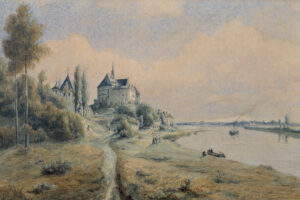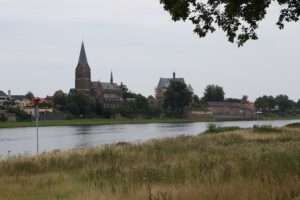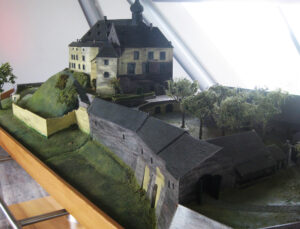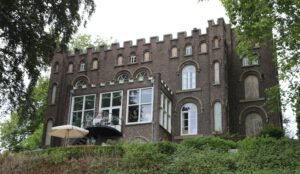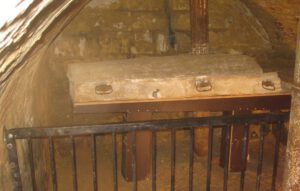 Over a century ago, the crew of a dutch fishing boat gets insane on the middle of the North Sea. Three men are cruelly assasinated by their collegues, after which the rest spend the days waiting for the apocalypse, whilst praying and singing psalms. What took posession of the crew of the KW 171, the fishing boat that history would call the fool’s lugger?
Over a century ago, the crew of a dutch fishing boat gets insane on the middle of the North Sea. Three men are cruelly assasinated by their collegues, after which the rest spend the days waiting for the apocalypse, whilst praying and singing psalms. What took posession of the crew of the KW 171, the fishing boat that history would call the fool’s lugger?
Slowly and carefully the norwegian steam vessel Jonas Reis approaches the drifting fishing boat. From the port side, the captain scrutinises the vessel under him. It is sunday September 12th 1915 on the Doggersbank, in the middle of the North Sea, about 130 miles east of Scarborough. The Jonas Reid has left Tyne the day before. Half an hour ago, the fishing boat caught the captain’s eye. It draw his attention because all sails were down at mid sea. But when they got nearer, the captain saw the sails were not just lowered, but torn apart. He immediately ordered the machine room to stop the propellor and now they get closer, the captain gets a sinister premonition.
That turns out to be right. By the time the vessel with registration number KW 171 on the hull is about 50 feet away from the Jonas Reid, the skipper perceives to his dismay a complete chaos on deck. Not only are the sails torn apart, the ship’s rigging is completely dismantled and the hatches and katrols are gone. Five or six men are spreaded on deck, answering the skipper’s look with frightened eyes. On the rear deck, the captain observes dark red spots. Blood? It takes him a while to get himself back together and call all hands on deck.
The KW 171, also known as North Sea 5, was a sailing lugger built in 1906, based in Katwijk. This dutch fishing village with a very closed character did not have its own harbour. In former ages they used tot sail on flatboats that would be pulled on the beach. After these more traditional ships were replaced by faster and therefore more efficient luggers, the Katwijk fleet was forced to divert to neighbouring harbours.
On Tuesday August 3th 1915 the KW 171 set sail from IJmuiden, 15 miles north from it’s hometown Katwijk. It was the second voyage with this 13 men crew under the command of the 39 years old skipper Nicolaas de Haas. Also on board were navigator Pieter van Duijn (28), Jacob Jonker (33), Klaas Kuijt, seaman and cook Reijn Ros, his 13 years old son Arie Ros, brothers Arie (28) and Leen (17) Vlieland, P. v/d Plas (43), P. Heemskerk (29), J. Kuijt (16), W. Huwwaard and 13 years old D. de Mol. The team got along very well and the first voyage had been a very pleasant one, according tot he skippers wife in a newspaper after the cruel event that would soon occur.
Katwijk in these years was a very orthodox religious community. The First World War raged outside and although the Netherlands remained neutral, the war cruelty did not bypass the village. Mines made the North Sea, that was the primary source of income for the fishing village, extremely dangerous to sail on and the dead bodies from submarined allied vessels flushed ashore in high numbers. The pietistic character of the local religion turned these experiences into the most fantastic fantasies. Apocalypse was near, so it was believed by many.
We know little about the five weeks following the departure of the KW 171. The lugger sailed northwest, destination Doggersbank, an area full of fish half way England and Denmark. The days probably passed as many others on Katwijk fishing boats in these days. Long hard work and beans, bacon and rice for dinner. Six days a week, for the compulsory Sunday rest counted at sea as much as at home.
The next sign of life from the KW 171 reaches IJmuiden via the skipper of KW 151 De Hoop. He tells about a meeting that he had a few days earlier on mid sea with the KW 171. A few crew had been on his vessel for a while to hand over letters and ask him to, once back in IJmuiden, send them to Katwijk. The skipper had asked them why, since they were heading back to Katwijk themselves. The answer surprised the skipper even more. “God himself destroyed Katwijk and made it vanish. We will not return to Katwijk, we are heading to Jerusalem, where God came down from heaven.” When the men climbed back in their jolly, one of them, who so far had stayed aside, grabbed the skippers arm, begging him to stay aboard with him. The skipper did not see the urge to grant his wis hand send the man back in the jolly. While the crew menbers of the KW 171 rowed back to their boat, the skipper of the KW 171 shouted tot them: “If I were you, I would go back to Katwijk. You are saying crazy things, I think you are going out of your mind!” Some time later, one of the seaman of the 171, Arie Vlieland, shouted back tot he skipper of the 151: “Cut your nets, get rid of the crap! Believe in God’s justice, for you are all doomed!”
It is obvious that by that time, things were terribly wrong aboard of the KW 171. According to the Katwijk-born author Robert Haasnoot, who based his novel ‘Waanzee’ on this history, the crew had been practicing their religion for weeks. Religion, superstition and the side effects of long time isolation at sea were a perfect breeding ground fort he upcoming evil.
There are two testimonies about the days following the encounter with the KW 151. In some details they contradict, but the whole stories are more or less the same. One of the youngest aboard, 13 year old Arie Ros, is interviewed by a newspaper, two weeks after the happening. Seaman Arie Vlieland, the evil genius of the drama, later talks tot he captain of RMS Prof. Buys, the vessel that takes him back tot he Netherlands.
The skipper of the KW 151 later tells the owner of the KW 171, director N. Haasnoot from North Sea Fishing, that during the mysterious meeting at sea, he got the impression that it wasn’t skipper Nicolaas de Haas, but seaman Arie Vlieland that was in actual command of the 171. Vlieland is known to have been an extraordinary strong man, huge and charismatic. All that made him a dominant personality. He mastered the Tale Kanaäs, a traditional, biblish way of speaking, that allowed him to manipulate his god-fearing ship mates. Katwijk had a culture of chosen ones and concerneds. The chosen ones were believers who claimed to get signs of God, what made them superiour tho the concerneds, who lacked such relevations.
Probabely madness creeped into chosen Vlieland’s mind during the voyage. According to witness Arie Ros, Vlieland said on Sunday September 5th that he felt the Holy Spirit within him. Next came four days of praying and discussing the Bible, followed by the killings. Vlieland himself stated that he wake up shortly before the first murder to talk with God, who ordered him to purify the ship from Satan’s presence. He was busy throwing overboard anything that could possibly contain demons, when Leen Vlieland and Van der Pals woke up. They claimed to have seen a red star and took that for a confirmation of Arie’s assertions. Sails, masts and ropes were thrown overboard.
Next morning, most of the crew joined the exorcism. Only Pieter van Duijn, Jacob Jonker and Klaas Kuijt refused. Their disbelief was not appreciated by Arie Vlieland, who forced Kuijt to alternating dance and stand still on deck for hours. It must have been an insane scene. “He looked as if he was posessed by the devil,” Arie Ros stated afterwards. For the crew it was reason enough to throw Kuijt overboard the next morning. When he tried to hold on to a rope, one of his mates chopped off his hand. Screaming from pain Kuijt disappeared in the water.
Or at least, that is Arie Ros’ statement. Vlieland told the captain of the Prof. Buys that they beheaded Kuijt before throwing his body in the sea, while singing psalms.
According to Arie Ros, navigator Pieter van Duijn went lower deck to beat up his father, Reijn Ros. But Ros Sr. Turned out to be tougher than Van Duijn and he kicked the latter under a bench. The rest of the crew mixed in though and beat Van Duijn with spades to death. Jonker chopped off his head with an axe.
After the murder Jonker went back on deck, where he bumped into skipper De Haas. “You have all gone crazy, do you really belive this nonsense!”, De Haas shouted, while Jonker kicked him down the stairs. De Haas locked himself in a berth, but the remaining crew dragged him out again to beat him to death with poles, brought tot hem by the young boys Arie Ros and D. de Mol. Arie Rol however said that the last two victims were stabbed to death. In both versions the bodies were thrown overboard.
On Sunday September 12th, the KW 171 was found by the Norwegian steamer and towed to Tyne. It was obvious that the whole crew had gone insane and the men were precautionary chained up on board of their own vessel.
The story of the fool’s lugger has always been unmentionnable in the Katwijk community. Although no-one else than the crew itself could be held responsible for their crimes, it seemed that the closed, religious people felt ashamed for them. During the first period after the disaster the people felt a sort of fear. Had it not been normal Katwijkers out there? If this could happen tot hem, it could happen to anyone.
That most survivors were back in town only a year after the massacre made even more difficult fort he people to get over. Also, almost everyone was related to everyone. A niece of the killed navigator Pieter van Duijn said many years later that her mother told her father off when he greeted one of the surviving crew members on the street. “Gerrit, how can you say hello to a man that killed your brother?”
The two 13 year old boys went straight back to Katwijk, the other eight were brought to mental hospitals. Within a year they were all back home in Katwijk, except for Arie Vlieland. He moved with his wife and children to Wassenaar near The Hague, where he died in 1966 at the age of 79.
And the KW 171? The lugger was restored, but no Katwijk fisherman dared to sail on it. The vessel was sold to a shipowner from IJmuiden. Registered IJM 251, it struck a mine two years later, taking eight sailormen tot he bottom of the North Sea.



